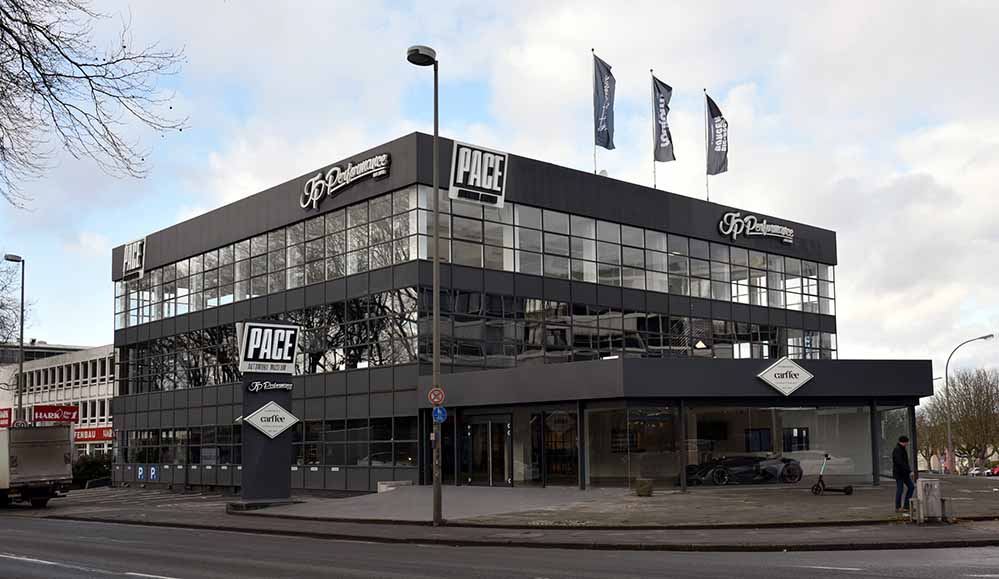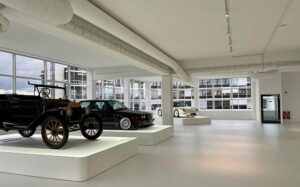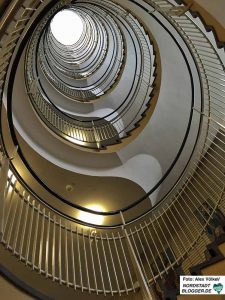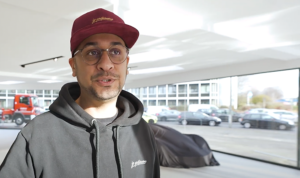Monument of the month January 2021: From the auto super market to the museum – Will Schwarz set standards on Westfalendamm

Angular instead of curvy – architect Will Schwarz changed his design language here. Photo: Michael Holtkötter
After only 90 minutes, a quarter of a million people had already seen the video of a new museum on the B1 with historic cars on a YouTube channel and commented on it euphorically. At this point in time, the museum was supposed to have been running for four weeks in the car dealership, which was opened in 1961, but this prevented the necessary regulations on the corona pandemic. The curiosity about the building with the historic vehicles is reason enough to present the old car dealership at Westfalendamm 106-108 as Monument of the Month January 2021.
Automobile changes in the world 60 years ago
The new owner bought the dealership a good year ago, fulfilling a childhood dream: “I wanted to buy the dealership much more than the cars as a child.” He grew up nearby – and was fascinated by the cars and the house stayed.
When the businessman Hans Wilke opened his car dealership on B1 in the autumn of 1961, the current owner was not even born. The world was changing. The Cold War was slowly coming to a head. New developments began to emerge in many areas: Yuri Gagarin was the first person to fly into space on April 12th. The young American President John F. Kennedy was the bearer of hope not only for the Americans, his wife Jackie influenced the clothing style worldwide as a fashion icon.
With the construction of the Berlin Wall on August 13, the existing structures of two German states seemed to have been permanently concreted. And the new television program “Music from Studio B” and the Hamburg Star Club gave the population access to international pop music.
Coming and going in the car world: the field of tension between the status symbol and the necessary vehicle

In his new car museum, JP Kraemer wants to give insights into car history. Photo: Michael Holtkötter
The Federal Statistical Office reported around five million cars for 1961, a doubling of the number within four years. On the one hand, the car gradually developed into a status symbol, but on the other hand it also became a necessary vehicle for getting to work.
Although the planners set the course for car-friendly cities during the reconstruction of Germany after the Second World War, private transport increasingly clogged the inner cities. In 1961, Kassel was the first major city to introduce the parking disc.
With around two million cars produced in 1960, Germany was the third largest producer in the world. In addition to many winners, there were also losers. The Bremer Borgward-Werke had to file for bankruptcy in 1961. In addition to the German models, demand also increased for car brands produced outside of Germany, above all Italy and France. Hans Wilke took up this tendency and sold Renault, Peugeot and Citroën cars in his dealership.
The “auto super market” sounds strange today, but was considered modern back then
The owner had the designation “Autohaus Wilke” affixed larger than the brand names. At the top of the roof, however, the neon letters “AUTO-SUPER-MARKT” were emblazoned in the evening. What sounds strange today was considered modern back then.
People bought their groceries less and less in the corner shop, but in the spacious supermarket with a diverse range of goods. The first large German supermarket opened in Cologne in 1957. However, the development started in 1930 near New York, when the world’s first supermarket was opened in an old auto repair shop.
It is not known whether Hans Wilke knew about it when he decided to call his business the auto super market. In addition to new French cars, he also offered used cars and had reserved the second floor for them. In this way, buying a used car was also a “neat” experience.
Angular instead of curvy – architect Will Schwarz changed his design language here

Architect Will Schwarz has left a lot of traces in Dortmund. This also includes the old health department – also a monument. Photo: Alex Völkel
The dealership was entered via a single-storey pavilion in front of it on a sloping floor plan. What seems like a reminiscence of the architecture of the 1950s was due to the lines of Westfalendamm and the confluent Vosskuhle, which the architect Will Schwarz took into account.
The path led from the pavilion into the actual commercial building, which was built as a three-storey cube with an edge length of approx. 30 m. A filigree grid of narrow steel rods is placed in front of the reinforced concrete frame construction and enables the facade to be completely glazed. The desired elegant look is particularly strong when the interior is illuminated in the evening.
Compared to other car dealerships at the same time in the city, the house on Westfalendamm has remained almost unchanged to this day, even after the renovation. It is part of the political, economic and social position that the automobile occupied in our society in the 1950s and early 1960s, and thus makes it a monument.
With this object, the architect Will Schwarz (1907 – 1992) changed his formal language. Up until then he was known in Dortmund primarily for his buildings for the 1959 Federal Garden Show (Florianturm and Park Café) and for the health department in the city center. The latter two in particular, completed in 1959/1961, show the cheerful, rather playful architecture of the 1950s with their curved shapes, colorful mosaics and integrated works of art. With the Wilke car dealership, Will Schwarz also began to follow the more rationalistic, angular architectural tendencies of the 1960s.
The elegant and transparent architecture was the best advertisement on the busy B1

Jean Pierre Kraemer (screenshot)
The choice of a reinforced concrete structure for the car dealership allowed for wide and spacious exhibition rooms inside. Schwarz had relocated the necessary office and common rooms to the side and into the recessed top floor, which was hidden behind the “AUTO-SUPER-MARKT” logo.
A car lift brought the cars to the upper floors. Hans Wilke had deliberately chosen the site on Westfalendamm. The elegant and transparent architecture was the best advertisement on the busy B1. The dealership quickly became a landmark with a high recognition value.
We will be able to see a lot of it in the Pace Automobil Museum, the video that has been clicked so often shows how the current owner Jean Pierre Kraemer imagined the opening. “This is what my imagination looked like … But we are not allowed to do that at the moment, which is not a problem because we wait,” it says at the end of the film. And we are all the more delighted to be able to immerse ourselves in car and contemporary history with a spectrum from the Beetle to the Formula 1 racing car.





